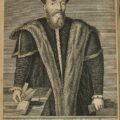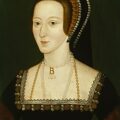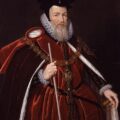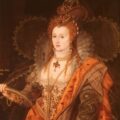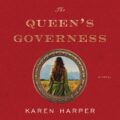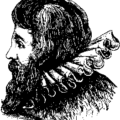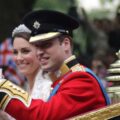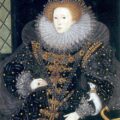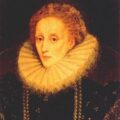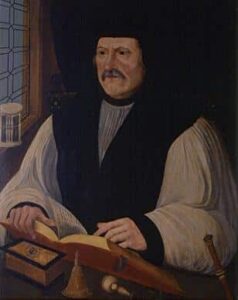
Back at the beginning of May, I wrote an article entitled “The Fall of Anne Boleyn” where I mentioned the fact that Anne Boleyn asked her chaplain, Matthew Parker, on the 26th April 1536 to ensure that her daughter, the future Elizabeth I, was looked after if anything happened to Anne. This request is important in three ways:-
- It shows that Anne was aware that her future was precarious and that something might happen to her
- It shows how much Anne cared for her daughter
- It shows Anne’s wisdom and the potential she saw in her small daughter – By entrusting Elizabeth’s care to Parker, a member of a group of wise Cambridge men, she was ensuring that Elizabeth would have the connections she needed to become a formidable woman and queen.
In the following article, Robert Parry, author of one of my favourite novels, “Virgin and the Crab”, explains the importance of one of Anne’s final acts and the connection between Anne Boleyn and Elizabeth I, which is deeper than simple genetics.
The Cambridge Connections
by Robert Parry
Thank you Claire for inviting me to write a few words on the Cambridge connections that helped to shape Elizabeth’s formative years, connections which I believe can also provide us with an attractive picture of continuity and shared purpose between Elizabeth as Queen and the life of her mother Anne Boleyn.
It’s easy to think of the two most prominent females of Tudor history, Elizabeth and Anne Boleyn, as being distinct and separate entities – and even today people are sometimes surprised to discover that Elizabeth was Anne Boleyn’s daughter. No doubt this is because we have so very few records of the two ever having been together, with Anne executed when Elizabeth was not even three years old. During her lifetime, moreover, Elizabeth made scant references to her mother, preferring – perhaps quite cleverly – to associate herself as being more her father’s daughter, in other words the daughter of a powerful king rather than of someone who ended her days under a cloud of dubious charges of adultery and treason. The connections are there, however, if we care to look a little deeper at the academic background of those who guided and educated Elizabeth during her childhood – connections that served her equally as effectively later on during her long and successful reign. The ones dealt with in this article can be summed up in one word: ‘Cambridge.’
For those who don’t live in Britain, a word of explanation might be in order about Cambridge. It is an old university town in the East of England and has been a major seat of learning for centuries. Rather like the friendly rivalry between Harvard and Yale universities in the US, in England we have had (since as far back as at least the 13th century) the two big universities of Oxford and Cambridge. Cambridge has been associated with many radical and influential thinkers over the years, including Erasmus, Francis Bacon, John Dee, Isaac Newton, Charles Darwin right up to our present day Stephen Hawkin. As many as 9 Poet Laureates and 15 British Prime Ministers have been graduates of Cambridge. It is also a place that became synonymous with radicalism during the cold war period of the 20th century when it was revealed that a network of Russian spies and double agents, including the infamous Philby, Burgess and Mclean had flourished there. It has, arguably, always been rather a hot-bed of intrigue and alternative thinking, therefore. And of course, during the 16th century there was not much that could be viewed as more ‘alternative’ than Protestantism.
Anne Boleyn was an early champion of the reformed religion, as has been made clear often in many of Claire’s excellent and revealing articles on The Anne Boleyn Files. When Anne believed she was about to be arrested and that possibly her days were numbered she placed her baby Elizabeth’s spiritual destiny into the hands of her then chaplain Matthew Parker (1504–1575). When in 1559 Elizabeth was finally crowned Queen, she eventually chose Parker to become her first Archbishop of Canterbury – the most senior post in the Anglican Church still to this day.
Matthew Parker was a Cambridge educated man. Born in 1504, he graduated BA in 1525 and thereafter continued what was to become a life-long association with the University. In 1544, on Henry VIII’s recommendation, he was elected master of Corpus Christi College and became vice-chancellor of the university itself in 1545. Parker was one of the primary architects of the emerging Anglican Doctrine that shaped the English Reformation and after the death of Henry VIII, he continued to rise to prominence under the reforming governments of Edward VI and was a close associate of the two most powerful statesmen of Edwards reign – Edward Seymour and John Dudley. He would have been intimately associated, therefore, with the influential Humanist movement of the first part of the 16th century that was centred on Cambridge and consisted of scholars such as John Cheke (1514–1557), William Grindal (d. 1548), Anthony Cooke (1504-1576); Roger Ascham (1515–1568), John Dee (1527–1608/9) and, perhaps most significantly of all, William Cecil (1520–1598).
The importance of Elizabeth’s Secretary of State William Cecil and, later, his son Robert during the reign of Elizabeth is well-documented and cannot really ever be overstated. In many respects he was the ‘prime minister’ of his times, and was involved in every important decision and political move that took place within the governing Privy Council. He was on intimate terms with everyone of importance, from Robert Dudley to Walter Raleigh, from Francis Walsingham to the Earl of Essex.
We will continue to explore these connections in Part Two of this article.
Thanks, Robert! An excellent article and how clever Anne was in choosing Parker! You can read my review of Robert’s “Virgin and the Crab” over at our Tudor Book Reviews site – click here.
